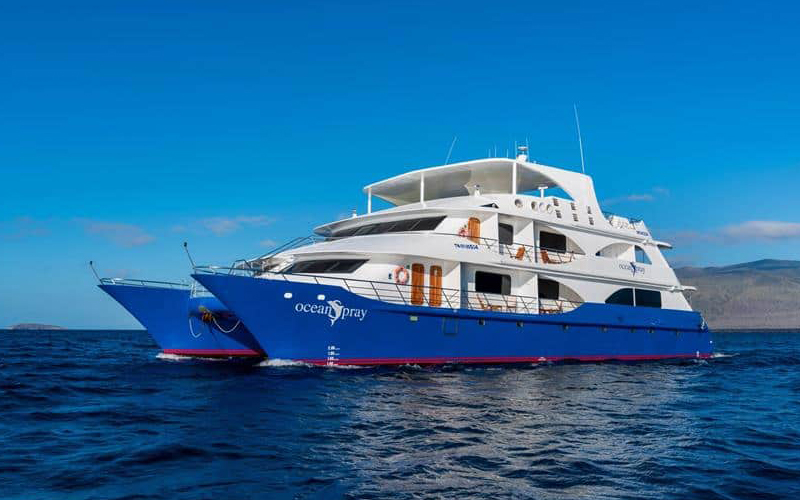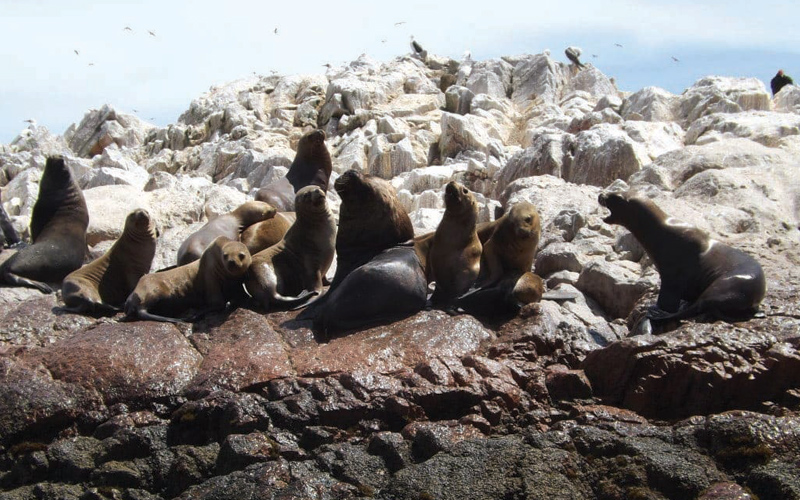Galapagos Islands Wildlife Encounters
For the adventurous, there are relatively very few places on Earth

that deliver such an extraordinary array of fauna and flora in such a primordial setting in the remote Galapagos Islands. Lying about 600 miles west of mainland Ecuador, these volcanic islands are the home to many, diverse species.
The archipelago has incredible biodiversity with over 5,000 species and 1,900 are endemic, including giant tortoises, marine iguanas, and Galapagos penguins, thriving in this tropical environment. These diverse species create a colorful spectacle, and it is delightful to watch a hatch of blue-footed boobies create such a stir by doing curious, rhythmic shuffles with their bright webbed feet. These birds create their own aura and perhaps even a sense of awe by catching flying fish off the surface, which are clearly booby trapped.
On land, these creatures appear quite comical, tottering along the rugged landscape, not so different from the struts of penguins. But don’t be fooled by their playful nature since in flight they are serious hunters in search of prey.
Other exciting features are viewing hundreds of white egrets flying en masse from one mangrove to another, creating a sensational burst of action, as if on cue for a staged performance. Different species prefer fishing enmasse including blue-footed boobies, sea lions, and even sharks, which stealthily sneak up to seize their prized catch. At night large whitetip sharks work in unison to pounce on flying fish. They even compete with a sea lion for the same tasty morsels coming to the surface of the Pacific.
These amazing spectacles are just some of the many natural wonders that characterize life in the Galapagos. Seeing nature so close provides an exceptional island experience. So much so, that ironically it is rarer to view a cruise ship on the horizon.
With much excitement, my visit to this island paradise is no longer a dream but becomes real when I am met at San Cristobal Airport to begin the adventure on the Golden Galapagos Cruises’ luxury vessel, Ocean Spray. I joined ten other guests to board the 113-foot catamaran. With the naturalist, Javier, and twelve crew members, this adventure would be with an intimate group looking forward to having personal, wildlife encounters in a spectacular setting.
For my adventure, I chose Golden Galapagos Cruises, which is one of the few luxury cruises sailing the archipelago with year-round itineraries that vary from 4 – 14 days.
On land, these creatures appear quite comical, tottering along the rugged landscape, not so different from the struts of penguins. But don’t be fooled by their playful nature since in flight they are serious hunters in search of prey.
Enhancing the experience, Golden Galapagos Cruises Marketing Director, Washington del Pino, says that the Ocean Spray catamaran is “one of 4 vessels in the fleet that cruises the Galapagos; all of which are carbon neutral.” This “sustainability means not only being environmentally responsible or socially aware of those around us, but also renewing our Golden Experience regularly so that yours is not only sustainable, but also uses the best technology available.”
I agree that this is one of the world’s rare destinations that has prioritized protection from hazardous waste and pollution. All around the islands, I observe that sustainable practices are being implemented to reduce the carbon footprint. Visitors are asked not to bring any outside agricultural, plant materials, or unprocessed food products to the islands. Even on my cruise, guests must follow sustainable practices by not bringing plastic, food, or waste to the Islands.
I am ready for adventure during my four day, three-night voyage around the eastern islands of San Cristobal, Floreana and Santa Cruz. For passengers, there are two options, dry landing and wet landing. In dry landing, passengers disembark from the yacht directly onto land. Whereas in a wet landing, passengers disembark from the moored yacht to a panga (dinghy) and step into shallow water. The idea is to take pangas and wade in the water to reach the beach. If I feel uncertain, the crew provides assistance to help me off the panga onto shore.
On Day 1, I snorkel among sea lions and view colorful clownfish, groupers, and other small fish moving swiftly in the currents.
At our next landing site at Los Lobos, our group climbs a trail to reach the rocky shoreline to see frigates, blue-footed boobies, and other exotic birds. We then reached a sea lion colony with a small pup wandering around to find its mother. The wildlife seems so tame. but when the animals sometimes move very near, we are asked to keep a distance of six feet if we can.
In the early evening, Javier provides a briefing on Charles Darwin, the world-famous 19th century naturalist, who took a five-week voyage on the HMS Beagle around the Galapagos. On each of the four islands that Darwin visited, he observed the variations, including distinctions in the finches’ beaks, which over time were adapted to take full advantage of food sources on the islands that they inhabited. Darwin’s theory of natural selectiontransforms our thinking on how new species or sub-groups gradually develop. Today it’s possible to see how adaptations continue to have significant impacts on developing new and sub-species in the Galapagos Islands.
On Day 2 at Punte Pitt, my fellow travelers and I have a wet landing, followed by an early hike uphill past an olivine beach through thorny scrub and past tuff cones with panoramic views of the ocean and the surroundings. There all three species of boobies can be seen in one place, including the highlight of viewing one of the only red-footed booby colonies in the archipelago. Other sightings include mockingbirds, finches, pelicans and sea lions. In the afternoon, the group has an opportunity to snorkel and swim at the nearby beach at Isla Lobos. While snorkeling, I use a a life buoy that attracts a sea lion who playfully swims through my ring. No doubt the sea lion sees the buoy as a toy and tries to take it away from me. I plan to let go of the buoy, but the sea lion suddenly loses interest and disappears under the surface.
At sunset, the cruise moves closer to view the magnificent Kicker Rock where I spot blue-footed boobies and frigatebirds darting in and out of the monolithic structures.
On Day 3, our group sets off on a kayak adventure to view wildlife, including seeing a pair of Galapagos penguins swim swiftly alongside the boats. Our cruise leads to the next adventure at Floreana Island. After a wet landing, the group disembarks and walks a short distance to Post Office Bay to find an old wooden postbox. At this site, we hear how sailors used to mail their letters by asking seamen from other ships to personally deliver their correspondence. Today tourists follow the tradition of taking unstamped postcards and delivering them when they return home.
The adventure continues with a chance to snorkel in the shallow waters where there are amazing green sea turtles and sea lions underwater. Later for those wanting more excitement, there are opportunities to swim atPunta Cormorant and snorkel at Devil’s Crown.
Late afternoon, we visited Floreana to hear about its interesting history that includes colorful tales of pirates, mutiny, and murder. It is one of the only two islands to have fresh water, but also is noted for its beauty with exotic vegetation along the coastal shore.
At sunset, it is fortunate to have a wonderful view of a small flock of pink flamingos wading in the tranquil water. The soft light makes the walk magical, while wandering past mangrove trees and hiking to the soft, white sandy beach. I marvel at seeing the fiery Sally Lightfoot crabs scurrying across black lava rock and a large marine iguana warming in the sun near a barren, volcanic outcrop. Yet one of the best moments is seeing a group of stingrays coming to shore in search of food.
At dawn on Day 4, the group has a dry landing and takes the pangas to tour Santa Cruz Island. As the last port of call, we watch an array of wildlife in the bay including white egrets flying aloft; white tip sharks moving silently; and large green sea turtles swimming peacefully underneath the mangrove trees. For a finale, the tour is characterized by seeing the mating of sea turtles in the shallow water near the pangas.
At sunset, it is fortunate to have a wonderful view of a small flock of pink flamingos wading in the tranquil water. The soft light makes the walk magical, wandering past mangrove trees and hiking to the soft, white sandy beach. I marvel at seeing the fiery Sally Lightfoot crabs scurrying across black lava rock and a large marine iguana warming in the sun near a barren, volcanic outcrop. Yet one of the best moments is seeing a group of stingrays coming to shore in search of food.
For some visitors, seeing the green sea turtles underwater is amazing, but the sea lions are as captivating, especially as they vie for our attention as they pose on the pier on Baltra Island.
In visiting the Galapagos, I have developed a deep appreciation of the island’s wildlife and ecosystems. Unlike anywhere else in the world, the islands are situated at a point where three ocean currents join, creating a unique area in the ocean where warm and varying degrees of cold water meet. This upwelling attracts a rich variety of endemic fauna and flora species.
However, it is a real concern that the archipelago is undergoing threats by climate change, especially with El Niño events creating changes in sea temperature and rainfall affecting the biodiversity across the islands. Despite these concerns, this special place is exceptionally beautiful, having abundant wildlife and a natural landscape that is unlike virtually anywhere else in the world.
These special qualities depend upon concerted efforts to preserve the natural environment and, most importantly, to keep the islands pristine as we know it.
Golden Galapagos Cruises has a fleet of four luxury catamarans including M/S Ocean Spray for wildlife encounters, guided expeditions and personal adventures to view unique species. Fifteen+ expeditions can be arranged from four – fourteen-day trips.
Golden Galapagos Cruises (877) 355-2034; info@goldengalapagoscruises.com




